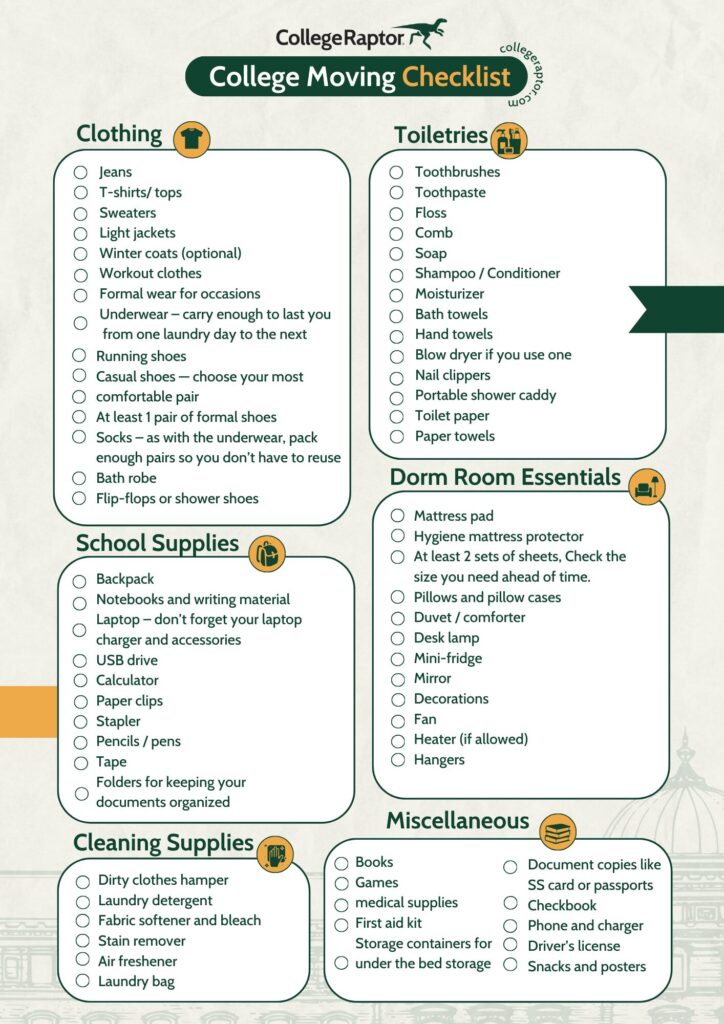It can be intimidating to try to choose one college from nearly 6,000 options. Even after you’ve received acceptance letters, making this decision can be a tough one! Thankfully, there are ways to narrow down your choices and choose the college that best fits you.
How to Choose a College in 9 Steps
- Start Your Search Early
- Find Schools That Match You
- Ask the Right Questions
- Schedule Campus Tours
- Look at the Numbers
- Check out Schools’ Online Presence
- Talk to the Right People
- Compare Your Options
- Common Mistakes to Avoid
1. Start Your Search Early
We can’t emphasize this enough – start your college search early. It takes time to explore different colleges and determine what they offer in terms of academics and extracurricular activities. You also want to know more about their location, their tuition fees, their dorms, and facilities, among other things. Finding that one school that’s the right fit for you in every way can take a considerable amount of time.
Starting too late can cause you to make the wrong choice when it comes to college. The earlier you start, the better your chances of zeroing in on that perfect school for you.
2. Find Schools that Match You
Before anything else, you need to find the college and universities that match you. But when there are 6,000 college options to choose from, how can you possibly narrow it down?
Using the right resources can help you cut down on the legwork here. College Raptor’s College Match is one example. College Match takes your information, wants, needs, achievements, and more and returns with a list of schools that best fit you as a student. You’ll be able to see your chances of getting an acceptance letter, what you need to improve your acceptance chances, how you stack up against other students, and why the school matches you.
Armed with this information, you can start to narrow down your options and create a solid list of schools to apply to.
3. Ask The Right Questions
Tools like College Match do a great job of highlighting the schools that best fit you, but you also need to be asking the right questions to make sure the college you choose has what you want and need. Here are a handful of questions to consider.
Is the College a Good Fit for You?
This is the main question: does the college fit you? You will want to think about
- How your academic profile compares to recently accepted students
- Your chances of acceptance
- Your major/minor and the strength of the school’s program
- Size, type, and atmosphere preferences
- Location preferences
- Extracurricular activities
Listing out your wants and needs in this category can help make it easier to narrow down the best schools to apply to. Make sure to also create a healthy mix of safety, reaches, and matches to increase your chances of receiving acceptance letters.
A lot of things come together to decide whether you should choose a specific college or not.
Will the College be Affordable for You?
Sticker price can scare a lot of students (and parents) off of a particular school. These numbers should be taken into consideration, but they don’t tell the whole story. Many colleges and universities, especially private ones, have endowment programs to help make college more affordable. Students should also complete the Free Application for Federal Student Aid (FAFSA) to qualify for these institutional grants and federal programs.
A sticker price can result in sticker shock, but thanks to these programs, you might pay a fraction of that cost (or nothing). Our College Match can help you determine how much you’ll actually pay to attend any particular college based on your own financial situation. Our Financial Aid Offer Comparison Tool can also help you identify the best deal once you’ve received your acceptance letters. In addition, students should be applying to scholarships and state grants to make college more affordable.
How Will The College Help You Reach Your Goals?
One of the most important considerations when it comes to choosing a college is how a particular school will help you reach your goals after graduation. Does it have your major? How does the program stack up against other schools that offer the same area of study? A good reputation is great, but if the college doesn’t have your desired major, you will be either stuck studying something else or be wasting your time.
Also consider:
- graduation rates
- first year retention rates
- job placements for alumni
- resources such as career centers and college advisors.
4. Schedule Campus Tours
5. Look at the Numbers
Taking a trip to campus or viewing the college’s website can tell you a lot about a school, but there are other factors to consider: the numbers. These can give you insight into how the college stacks up against similar colleges in the United States. Two numbers we recommend paying attention to are the rankings and the statistics.
Consider Rankings – Wisely
College Raptor publishes its own College Rankings based on a host of factors including academic achievement, retention rates, graduation rate, and more. While these factors can serve as a sort of proxy for education quality, rankings can ultimately only tell you so much about an institution.
For example, you know Harvard University is a good school, but if you aren’t interested in Harvard or don’t have the grades or extracurriculars to get an acceptance letter, the fact that it made the list of top 50 schools in the country may mean little to nothing for you.
However, that doesn’t mean you should throw rankings out the window, either. They can help you find colleges you’ve never heard of before, and see how they compare to other schools you’re looking into. For example, College Raptor’s Hidden Gems highlights some lesser known colleges from around the United States. You might just find your dream college on one of these.
Review the Statistics
Rankings take the statistics into consideration when determining the “top schools” to be on each list. You should look at these numbers individually. College Match from College Raptor actually has these numbers on schools’ profiles. Here are some to keep an eye on:
Admission Statistics
Admission statistics can give you information about how many students apply to a college and how many students are accepted out of that pool. Students can get some insight into how likely they are to receive an acceptance letter based on these numbers and how they can improve their acceptance chances. You should look into:
- Number of applications
- Number of accepted students
- Acceptance rate
- Enrollment total
- Yield (percentage of students who accepted the school’s offer)
Graduation Rate
College Raptor lists 4 year, 6 year, and 8 year graduation rates. These percentages highlight how many students graduated after 4, 6, and 8 years at the college. The higher the percentage, the more students stayed at the college to earn their degree. If the college has a lower percentage, interested students should look into why others are leaving the school early.
Student-to-Faculty Ratio
A student-to-faculty ratio highlights how many students there are per faculty. It’s determined by dividing the total number of students by the total number of professors at the college. Lower ratios could mean more intimate class sizes and more time for professors to have 1 on 1 time with their students during office hours. Higher ratios may mean the college is bigger and classes tend to be lecture style.
First Year Retention Rate
This number tells you how many students stayed on after they completed their first year of college. For example, Harvard, as of this writing, has a 98% first year retention rate. This means that 2% of students left after the first year – they usually either transferred or decided to leave college.
As with lower graduation rates, if a college has a lower first year retention rate, students should investigate the “why” behind this statistic. You might find interesting information about the school that influences your decision to attend, or you could discover the reason they’re leaving is not a reason you’d leave.
6. Check Out Schools’ Online Presence
Almost all schools are going to have a robust online presence at this point. Their website, social media, and other publications can provide amazing insight into what the school offers, how they talk to their students, extracurriculars, and more.
Keep in mind, though, that the school’s website and social media posts will be carefully curated. It’s important to look at unofficial information, such as the comments, Subreddits, and college newspapers. You can look into life on a campus using these resources.
7. Talk to The Right People
You don’t have to do all the research behind the computer screen or keep to the campus tour! In fact, it’s highly recommended you talk to current students and representatives from the school when you can.
Ask Current Students Questions
Asking current students or alumni questions at a college can help you get a “real” answer. As mentioned above, many colleges only publish curated material. The student you talk to who is relaxing on the quad isn’t going to give you a curated answer. They’re going to answer your question honestly.
One question you might want to consider asking is “If you could change one thing about this school, what would you change?” If they tell you it’s the quality of the ground beef, that’s probably not something you need to worry about. But, if they tell you that they can’t get into the classes they need, won’t graduate on time, or find it difficult gaining access to their professors, you might feel differently about your own future there.
Attend College Fairs
Attending college fairs is an efficient way to get information about different colleges in one place. At these, you’ll meet college representatives who will go out of their way to answer all your questions. You can find some real hidden gems at college fairs, too.
College fairs can be found at local colleges, organizations, and high schools throughout the academic year. A simple search online can help you identify some in your area, but if you’re having trouble, be sure to ask your guidance counselor or college advisor about the schedule.
Reach Out to the College With Any Questions
If you have a question about a school, you don’t have to wait until your college tour to ask. Your tour guide may not even know the answer! You can ask questions on the school’s social media pages or through their contact form on their website. You might also want to reach out directly to the admissions department if you have concerns about the application process or the financial aid department if you have questions about your offer or their scholarship opportunities.
Discuss Your Ideas with Family, Advisors, and Teachers
After you’ve done your initial research, it’s time to open up a discussion with your family. Talk to your parents about your academic interests and career goals. Tell them about the schools you’re considering applying to. Most importantly, talk about the cost of attending college. Now is the time to have that critical money talk. Don’t presume anything. You have to ask your parents what kind of support they can give you. That will help you narrow your choices based on the tuition fees.
You should also schedule a meeting with your guidance counselor, career counselor, or college advisor (different high schools call them different things) to review your options and discuss your goals. They often have connections with colleges and can provide you some amazing advice that could result in an acceptance letter.
Talking your options over with your favorite teachers can also be insightful. They’ve attended college themselves, after all, and they’ve seen countless students graduate and go on to earn college degrees. Teachers will have some advice for their students that can pay off big time during the application process and beyond.
8. Compare Your Options
Once you have a few colleges you’re considering, it’s time to compare your options. Making a spreadsheet with the schools can help you compare them against your wants and needs. For example, how does one college’s financial program compare to another’s? When you write it all out, you’ll be able to clearly see the schools that fit what you’re looking for and colleges that don’t make the cut.
When you receive your acceptance letters, you will often have to return to this step, especially if you’re torn between a few schools. If the answer isn’t clear to you, try comparing your award letters them again and scheduling another visit to the campuses.
9. Don’t Make These Common Mistakes
Mistakes during the college search process can be costly. You might pick out the wrong schools, start too late, or not have a solid match of reach, match, and safety schools that fit your unique needs. Here are a few you’ll want to steer clear from.
Only Considering Prestige
Harvard University, MIT, and Princeton University are amazing schools. However, they’re not going to fit the needs of every student out there.
You should never apply to a school simply because of its “prestige.” Doing so can result in you going to a college that’s a poor fit for you.
For example, in my own experience, a family member told me I had better apply to a certain school just because they personally heard it was a good college and was known for its prestige. I researched the college and it turns out they didn’t even have my intended major. Simply following their advice could have proven costly for me.
Not Looking Beyond the Surface
Many students get overwhelmed during their senior year of high school, between your SAT/ACT tests, high school courses, and college applications. This can make it all too easy to simply look at the surface of a college and not do a deep dive. If you’re only scratching the surface, you’re not getting real insight into whether or not the school is right for you.
Starting early can help you avoid this mistake.
Only Considering the Input of Others
Your parents, teachers, relatives and advisors during high school all will have their own suggestions and opinions of which college they think you should choose. They’ll provide advice (unwanted or not) on majors, career choices, colleges, locations, and more. It can be a lot, especially if it’s coming from a lot of different angles.
It’s important to consider what you want out of a college – not what everyone else wants. You will be the one attending, and it’s important to do research beyond these conversations.
A common mistake students make in regards to this is simply attending their parents’ alma matter because they were told to. Parents are often nostalgic about their colleges and may heavily suggest their child attend there, too. Just because a school was right for your parents, doesn’t mean it’ll be right for you. You have your own unique personality, study style, dreams, and goals, which may be completely different from that of your parents. Nostalgia and emotions are not factors that should go into choosing a college. Be objective and refer to your list when narrowing down your choice of colleges.
Simply Going Where Your Friends Are Going
This one is all too common, and yet it’s still surprising how many students actually do this. They choose a college simply because that’s where their friend or significant other is headed, regardless of whether or not it is right for them.
Choosing a college is a major decision – one that will have a bearing on your whole future. You need to put some more thought into this decision rather than just following your best friend, partner, or friend group. Besides, the most exciting part of college life is meeting and making new friends. It’s a great way to expand your circle of friends and grow as a person.
That doesn’t mean you have to leave your high school friends behind. You can always hang out online together, chat over social media, and plan meetups when you’re both back in town during your breaks.
Your friend found the college that is right for them – now it is time for you to find the college that is right for you.
Most colleges require applications by January 1st, so you should have a few schools you want to apply to by this date. However, once you receive your acceptance letters, you will often have to make your decision by May 1st. Comparing the schools to your wants and needs will help you make your choice.
Struggling to compare colleges? Not sure which schools meet your academic achievements and goals? Our College Match tool can help you narrow down your options and find the best schools for you! Get started today for free.








The time has come for me to go back to college, and I need help trying to decide where to go. Any advice would be considered helpful. I like how you pointed out is something that I will want to look at is the retention rate, because that will help me understand whether this is a school people want to come back to or not. That is something that will be very helpful, because why would I want to choose a school that most students don’t go back to after their first year? Thanks for all of your help!